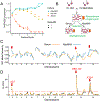Bulk segregant linkage mapping for rodent and human malaria parasites
- PMID: 36007706
- PMCID: PMC11972598
- DOI: 10.1016/j.parint.2022.102653
Bulk segregant linkage mapping for rodent and human malaria parasites
Abstract
In 2005 Richard Carter's group surprised the malaria genetics community with an elegant approach to rapidly mapping the genetic basis of phenotypic traits in rodent malaria parasites. This approach, which he termed "linkage group selection", utilized bulk pools of progeny, rather than individual clones, and exploited simple selection schemes to identify genome regions underlying resistance to drug treatment (or other phenotypes). This work was the first application of "bulk segregant" methodologies for genetic mapping in microbes: this approach is now widely used in yeast, and across multiple recombining pathogens ranging from Aspergillus fungi to Schistosome parasites. Genetic crosses of human malaria parasites (for which Richard Carter was also a pioneer) can now be conducted in humanized mice, providing new opportunities for exploiting bulk segregant approaches for a wide variety of malaria parasite traits. We review the application of bulk segregant approaches to mapping malaria parasite traits and suggest additional developments that may further expand the utility of this powerful approach.
Keywords: Bulk segregant analysis; Genetic crosses; Genotype; Linkage group selection; Phenotype.
Copyright © 2022 The Authors. Published by Elsevier B.V. All rights reserved.
Conflict of interest statement
Declaration of Competing Interest None.
Figures




Similar articles
-
Genetic mapping of determinants in drug resistance, virulence, disease susceptibility, and interaction of host-rodent malaria parasites.Parasitol Int. 2022 Dec;91:102637. doi: 10.1016/j.parint.2022.102637. Epub 2022 Aug 1. Parasitol Int. 2022. PMID: 35926693 Free PMC article. Review.
-
On the genetics of malaria parasites, a memoir: Part I, rodent malaria parasites and the first genetic crosses.Parasitol Int. 2022 Dec;91:102635. doi: 10.1016/j.parint.2022.102635. Epub 2022 Jul 29. Parasitol Int. 2022. PMID: 35914699
-
Protocol for production of a genetic cross of the rodent malaria parasites.J Vis Exp. 2011 Jan 3;(47):2365. doi: 10.3791/2365. J Vis Exp. 2011. PMID: 21248692 Free PMC article.
-
Efficient linkage mapping using exome capture and extreme QTL in schistosome parasites.BMC Genomics. 2014 Jul 21;15(1):617. doi: 10.1186/1471-2164-15-617. BMC Genomics. 2014. PMID: 25048426 Free PMC article.
-
Genetic Crosses and Linkage Mapping in Schistosome Parasites.Trends Parasitol. 2018 Nov;34(11):982-996. doi: 10.1016/j.pt.2018.08.001. Epub 2018 Aug 24. Trends Parasitol. 2018. PMID: 30150002 Free PMC article. Review.
Cited by
-
Mapping the genomic landscape of multidrug resistance in Plasmodium falciparum and its impact on parasite fitness.Sci Adv. 2023 Nov 10;9(45):eadi2364. doi: 10.1126/sciadv.adi2364. Epub 2023 Nov 8. Sci Adv. 2023. PMID: 37939186 Free PMC article.
-
Genetic crosses reveal genomic loci responsible for virulence in Cryptosporidium parvum infection.bioRxiv [Preprint]. 2025 May 21:2025.05.20.655157. doi: 10.1101/2025.05.20.655157. bioRxiv. 2025. PMID: 40475546 Free PMC article. Preprint.
-
Genetic crosses within and between species of Cryptosporidium.Proc Natl Acad Sci U S A. 2024 Jan 2;121(1):e2313210120. doi: 10.1073/pnas.2313210120. Epub 2023 Dec 26. Proc Natl Acad Sci U S A. 2024. PMID: 38147547 Free PMC article.
-
Advantages of outcrossing in Plasmodium falciparum: insights from genetic crosses using fluorescent labelled parasites.bioRxiv [Preprint]. 2025 Jul 31:2025.07.18.665596. doi: 10.1101/2025.07.18.665596. bioRxiv. 2025. PMID: 40766536 Free PMC article. Preprint.
References
-
- Su X, Ferdig MT, Huang Y, Huynh CQ, Liu A, You J, Wootton JC, Wellems TE, A genetic map and recombination parameters of the human malaria parasite plasmodium falciparum, Science 286 (5443) (1999) 1351–1353. - PubMed
-
- Hunt P, Martinelli A, Fawcett R, Carlton J, Carter R, Walliker D, Gene synteny and chloroquine resistance in plasmodium chabaudi, Mol. Biochem. Parasitol 136 (2) (2004) 157–164. - PubMed
-
- Su X, Kirkman LA, Fujioka H, Wellems TE, Complex polymorphisms in an approximately 330 kDa protein are linked to chloroquine-resistant P. falciparum in Southeast Asia and Africa, Cell 91 (5) (1997) 593–603. - PubMed
Publication types
MeSH terms
Grants and funding
LinkOut - more resources
Full Text Sources
Medical

